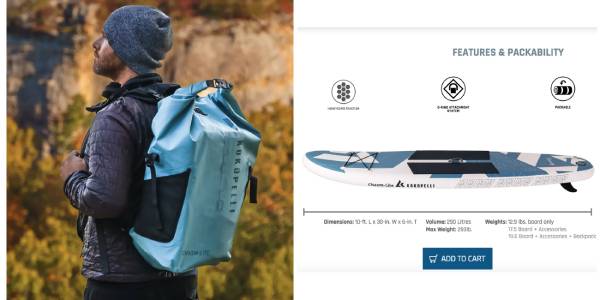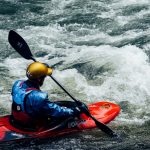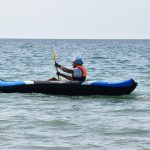Before discussing the dangers associated with kayaking and the steps one can take to avoid them, it is beneficial to identify the difference between imagined risks and genuine risks. Perceived danger is the level of danger one perceives a situation to be. At the same time, the true hazard is how perilous a situation is in reality.
For instance, you may think it is okay to paddle close to the shore of a little, still lake or river. Except for extreme weather, it probably is safe. Kayaking through Class IV rapids poses a considerable danger, in spite of your level of expertise. Hopefully, you perceive it as a considerable risk too.
Perceived Risk vs. Actual Risk
For a lot of activities considered to be extreme sports or adventure sports, like kayaking, the risk is usually more perceived than real so long as the proper safety regulations are observed.
The advantage of when a situation seems to have a high risk associated with it is that you will likely be more cautious and take the necessary precautions in order to avoid any unforeseen dangers instead of engaging in unnecessary risk-taking.
The negative aspect is that the feeling that the risk is greater than it actually is might cause you to feel apprehensive about venturing onto the water. Hopefully, this article will help you find the balance.
In reality, mishaps occur when the expected danger is not taken seriously, while the genuine threat is considerable. That means when you assume a situation is innocuous, but it has potential risks. It can be difficult to recognize the potential risks involved when participating in watersports if you are inexperienced.
An illustration of this would be kayaking in places with strong currents or massive rocks. It is often hard to identify hazards when looking from the top of the water, which can make it easy to get into a precarious situation if one is not familiar with the area.
Having practice in correlating your idea of the danger with the real degree is an ability that can be acquired through time and experience. It is advised that those starting out in kayaking should collaborate with a skilled paddler, become a member of a kayaking club, or at least attend a kayak safety class.
Being aware of potential hazards ahead of time will decrease the chances of having an accident.
What Is Kayaking?
Before considering the potential risks associated with kayaking, it is essential to understand what the activity entails. Many of us recognize that kayaking is a widely enjoyed aquatic activity.
Did you know that the vessels used for kayaking go by the name of kayaks?
This sport got its name from the vessels that are used to participate in it. You can kayak in any kind of water body. Generally, kayaking includes paddling in a low-sitting boat. The boat is narrow and enclosed. Usually, at first, kayaks were for only one person.
Currently, tandem kayaks have become increasingly popular, and big enough to accommodate two or three individuals. Different kayaks exist, based on their size and purpose. The kayaks have a lower than usual deck that is situated close to the water.
The boats possess remarkable speed for their diminutive size and peculiar configuration.
What Are The Dangers Of Kayaking?
Kayaking is steadily gaining recognition as one of the premier watersports. People who are on vacation or seeking adventure are becoming more enthusiastic about this exciting water experience.
The boat ride is indeed thrilling. We are all aware that along with the excitement, there is a certain degree of risk associated with an adventure. There are some risks in kayaking too. The dangers of kayaking are mentioned here,
1. Hypothermia
What Happens – The name suggests two phrases. The phrases are hypo and thermia. Hypo means low, and thermia indicates temperature. Kayaking affects the physiological condition of the paddler. After being in the water for an extended period of time, the body’s temperature will drop.
This is the primary danger of kayaking. It’s a well-known fact that rivers and sea waters are freezing cold. The cold water reduces body temperature quickly. This phenomenon is known as Hypothermia.
Solution – There are many solutions for avoiding Hypothermia.
We suggest-
1. You should go far from the shore. This way, the rescuers will be able to provide you with quick assistance should you experience any difficulties.
2. You can paddle with your partner. He can provide quick assistance in times of crisis.
3. We recommend wearing waterproof clothing. This can be used as a shield for your body from freezing waters.
4. Please carry an extra set of dry clothing.
2. Cold Shock
Many people experience a sudden drop in temperature when exposed to cold water. A stuffy chest and an unexpected heaviness in the head are indicators of a cold shock. At the beginning of kayaking, the paddler experiences a particular feeling.
The nervous system is abruptly triggered intensely and can cease functioning irrevocably. Chilly temperatures can bring about a swift stroke or blockage of the heart.
An answer to what to do if one experiences a cold shock while kayaking is…
1. We suggest you wear waterproof clothing.
2. Try entering into the cold water slowly at first. This can assist your body in dealing with the frigidness of the water.
3. Have a partner to paddle with. He can save you in need.
3. Inappropriate Use Of PFD
It’s absolutely essential to wear a personal flotation device when going kayaking. A PFD can save you from drowning. The biggest blunder made by kayakers is not strapping on their life jacket securely. This mistake causes severe injury, accidents, and even death.
One way to diminish the risk of accidents is to take note of the advice given here.
1. Always use PFD during kayaking.
2. Getting professional advice to properly put on a Personal Floatation Device is recommended.
3. Be sure the personal flotation device fits properly, not too snug or too loose.
4. Sun Exposure
The sunshine from the sun directly shines on your body while you are kayaking. Exposure to sunlight causes exhaustion and dehydration. Heatstroke is also a dangerous result of sun exposure. Moreover, the water reflects the sunlight. This reflection hits your body, causing sunburn.
The risks associated with kayaking are low, one of which is overexposure to the sun. One way to reduce the chances of having too much exposure is to utilize these tips.
1. Be sure to wear eye protection while kayaking in order to prevent direct sunlight from hitting your eyes.
2. We suggest you use sunscreen to avoid sunburn.
5. Undercut
If you engage in the sport of paddling, you will be familiar with the concept of an undercut. The undercut is an area with hollow depression. The undercuts are very dangerous for kayaking. The paddlers can end up unintentionally getting stuck in a hidden indentation when they are in the water.
A practiced oarsman can be of assistance in preventing underwater recesses. The other solutions are,
1. Wear a life jacket to protect yourself from drowning.
2. Don’t be confused. Gather your energy and stay composed if you are stuck in a forceful water current while kayaking. Think quickly for a way out.
6. Sweepers
Sweepers are the logs and sticks that have been swept away by the current of the water body. Sweepers are not completely disconnected and submerged in the liquid. If someone on a kayak happens to grab onto the sweepers, the boat can capsize. Everyone loses balance and falls into the water.
The answer to avoiding potential risks when using a kayak is to abide by the regulations.
1. You should avoid being too close to the sweepers.
2. Try not to hold on to the sweepers.
7. Adverse Weather Conditions
It is likely evident that kayaks do not offer a great deal of defense from the elements. A tiny bit of rain won’t hurt you, but you should never be misguided enough to go kayaking in a tempest.
It would be a good idea to delay a journey in a kayak if there is going to be thunder and lightning according to the weather forecast. You can also be in danger due to strong winds, haze, and intense sunlight.
On certain days, the weather can take a surprising shift. You could have begun rowing in the boat before the sky became cloudy. Observe and be cautious in these situations, and always choose the more cautious option.
Remain close to the shore in strong winds and be ready to get out of the water if the situation gets worse.
8. Waves, Tides, and Currents
You may expect that large swell are foremost among the things to look out for, but remember that you can be pulled off route by an invisible rip current too. It is essential to comprehend the body of water that you are paddling on in order to reduce the chances of harm.
It is thus vital to plot a course before kayaking or paddle with somebody who is familiar with the region.
Even if you have paddled a particular route before, there may still be unexpected components if you haven’t undertaken the necessary investigation beforehand. Don’t neglect to take into consideration the meteorological conditions on the day of, and prior to, your journey when it comes to determining water levels.
For example, after a heavy rainfall, class III rapids can increase in difficulty to reach class IV or V. In the same way, a calm stream can turn into a rapid torrent when it overflows.
9. Strainers and Sweepers
Though they may appear exciting, strainers and sweepers can be very hazardous to encounter when on the water. So, what are strainers and sweepers exactly?
Branches extending out of the water that are positioned low on the surface are often considered an impediment and are referred to as sweepers. Besides the danger of hitting one’s head, sweepers usually come with sifters.
Sieves are similar in nature, yet the obstructions protrude from below the surface of the water, hindering bits and pieces from passing through the water current. These can consist of everything from slim twigs to big logs or whole trees.
As an alternative, strainers could be manufactured items such as bars or grates. The gist of it is, they filter out the water but they also block any object that is too big to go through, including your kayak.
It can be difficult to locate strainers because most or all of them are beneath the surface of the water. It is essential to keep a cool head and stay in control when confronting strainers. Additionally, aim the bow of the boat into the strainer for the most effective result.
Familiarizing yourself with the voyage ahead and inspecting streams following strong showers and thunderstorms can help you steer clear of sweepers and strainers.
10. Weirs/Low Head Dams
Man-made structures referred to as low head dams or weirs in the United Kingdom are built to regulate the water level of rivers. Though useful, the river features referenced have earned themselves some not-so-pleasant titles: “drowning machines” and “killer in our river.”
As such, it’s only right that they are included in this text.
Why are weirs/low head dams so dangerous? Essentially, when water plummets over a weir, it produces a form of swirling motion that is similar to a washing machine, and consequently traps swimmers and smaller vessels.
British Canoeing has a thorough explanation of how weirs operate, the various kinds they come in, as well as how to identify when you are coming close to one.
Typically in the U.K., caution signs are posted near weirs, providing people with ample opportunity to alter their direction, reverse their route, or move the canoe manually to get around the weir.
Nonetheless, you can’t depend solely on notices of caution since weirs and lower hydraulic dams aren’t always identified. Additionally, signage can be knocked down or concealed by foliage.
Alternately, it is important to remember that weirs are not inevitably hazardous. Some weirs have a small fall and a gentle response, rendering them safe enough to navigate with a paddle.
Familiarity with the river you are kayaking in, in combination with the safety regulations for waterfalls, should protect you while canoeing on rivers.
11. Undercut Rocks
Water moving at a rapid speed erodes the material below the surface of a rock or mud bank, resulting in an area where the liquid can pass underneath. Kayaks have a tendency to be pulled underwater, the same as other objects that may be carried downstream, making it difficult, if not impossible, to free oneself from the kayak.
It is highly advisable to wear a well-fitting personal flotation device (PFD) and protective headgear any time rapids, even those of a Class I rating, are present.
This is especially important due to the dangerous undercuts that can occur. Even though suitable safety equipment may be available, rescuing someone or getting away from an undercut can be incredibly challenging.
Go for a stroll along the river and seek out the evidence of a bank that’s been hollowed out, before you get in your kayak.
12. Wildlife
Kayaking presents an excellent opportunity to explore and observe the animals that inhabit the same body of water. The most fascinating wildlife I have ever witnessed consisted of two seals taking a nap in the sun, some jellyfish, and a gaggle of irritated swansâ??nothing terribly extraordinary.
It could be dangerous to bother the wild animals in your home area, because it could include things like water snakes, alligators, crocs, bears, or even a nosy shark. I’d rather not run into any of them.
That said, wildlife attacks on kayakers are rare. Most of the time, wild animals would rather stay concealed or keep away from you if you demonstrate them politeness.
Most wild animals only attack when they feel threatened. Keep away from wild animals, particularly during the breeding season and afterwards, regardless of how great your selfie might turn out to be!




